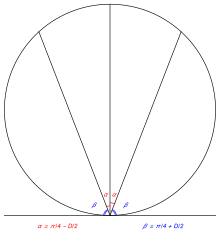
In mathematics, the Dottie number is a constant that is the unique real root of the equation
- ,
where the argument of is in radians.
The decimal expansion of the Dottie number is given by:
Since is decreasing and its derivative is non-zero at , it only crosses zero at one point. This implies that the equation has only one real solution. It is the single real-valued fixed point of the cosine function and is a nontrivial example of a universal attracting fixed point. It is also a transcendental number because of the Lindemann–Weierstrass theorem. The generalised case for a complex variable has infinitely many roots, but unlike the Dottie number, they are not attracting fixed points.

The name of the constant originates from a professor of French named Dottie who observed the number by repeatedly pressing the cosine button on her calculator.
The Dottie number, for which an exact series expansion can be obtained using the Faà di Bruno formula, has interesting connections with the Kepler and Bertrand's circle problems.
Identities
The Dottie number appears in the closed form expression of some integrals:
Using the Taylor series of the inverse of at (or equivalently, the Lagrange inversion theorem), the Dottie number can be expressed as the infinite series:
where each is a rational number defined for odd n as
The Dottie number can also be expressed as:
where is the inverse of the regularized beta function. This value can be obtained using Kepler's equation, along with other equivalent closed forms.
In Microsoft Excel and LibreOffice Calc spreadsheets, the Dottie number can be expressed in closed form as SQRT(1-(2*BETA.INV(1/2,1/2,3/2)-1)^2). In the Mathematica computer algebra system, the Dottie number is Sqrt - 1)^2].
Another closed form representation:
where is the inverse survival function of Student's t-distribution. In Microsoft Excel and LibreOffice Calc, due to the specifics of the realization of `TINV` function, this can be expressed as formulas 2 *SQRT(3)* TINV(1/2, 3)/(TINV(1/2, 3)^2+3) and TANH(2*ATANH(1/SQRT(3) * TINV(1/2,3))).
Notes
- If a calculator is set to take angles in degrees, the sequence of numbers will instead converge to , the root of .
- Kaplan does not give an explicit formula for the terms of the series, which follows trivially from the Lagrange inversion theorem.
References
- Eric W. Weisstein. "Dottie Number".
- ^ Kaplan, Samuel R (February 2007). "The Dottie Number" (PDF). Mathematics Magazine. 80: 73. doi:10.1080/0025570X.2007.11953455. S2CID 125871044. Retrieved 29 November 2017.
- Sloane, N. J. A. (ed.). "Sequence A330119". The On-Line Encyclopedia of Integer Sequences. OEIS Foundation.
- ^ Pain, Jean-Christophe (2023). "An exact series expansion for the Dottie number". arXiv:2303.17962.
- Michos, Alexander (2023-03-03), A Brief Investigation of an Integral Representation of Dottie's Number, doi:10.31219/osf.io/3rzj5, retrieved 2024-09-24
- "Integral Representation of the Dottie Number". Mathematics Stack Exchange.
- "OEIS A302977 Numerators of the rational factor of Kaplan's series for the Dottie number". oeis.org. Retrieved 2019-05-26.
- "A306254 - OEIS". oeis.org. Retrieved 2019-07-22.
External links
- Miller, T. H. (Feb 1890). "On the numerical values of the roots of the equation cosx = x". Proceedings of the Edinburgh Mathematical Society. 9: 80–83. doi:10.1017/S0013091500030868.
- Salov, Valerii (2012). "Inevitable Dottie Number. Iterals of cosine and sine". arXiv:1212.1027.
- Azarian, Mohammad K. (2008). "ON THE FIXED POINTS OF A FUNCTION AND THE FIXED POINTS OF ITS COMPOSITE FUNCTIONS" (PDF). International Journal of Pure and Applied Mathematics.
| Irrational numbers | ||
|---|---|---|
|  | |
 ,
, is in
is in  is
is  , it only crosses zero at one point. This implies that the equation
, it only crosses zero at one point. This implies that the equation  has only one real solution. It is the single
has only one real solution. It is the single  for a complex variable
for a complex variable  has infinitely many roots, but unlike the Dottie number, they are not attracting fixed points.
has infinitely many roots, but unlike the Dottie number, they are not attracting fixed points.


 at
at  (or equivalently, the
(or equivalently, the 
 is a
is a 

 is the inverse of the regularized
is the inverse of the regularized 
 is the inverse survival function of
is the inverse survival function of  , the root of
, the root of  .
.